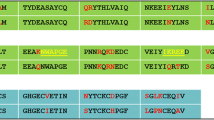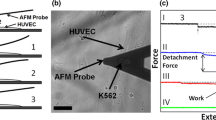Abstract
The heterogeneous distribution of endothelial cell adhesion molecules (ECAMs) on the lumenal surface of vascular endothelium provides an opportunity to deliver drugs to select tissues. The targeting could be achieved by using carriers whose outer surface has a ligand for a selectively expressed ECAM. The carriers would interact with the endothelium in a fluid dynamic environment and in many of these schemes nanoparticles would be used. It is unclear what role various parameters (e.g., ligand–ECAM chemistry, fluid shear) will have on the adhesion of the nanoparticles to the endothelium. To facilitate studies in this area, we have developed a prototypical in vitro model that allows investigation of nanoparticle adhesion. We coated polystyrene nanospheres with a humanized mAb (HuEP5C7.g2) that recognizes the ECAMs E- and P-selectin. Adhesion assays revealed that HuEP5C7.g2 nanospheres exhibit augmented, specific adhesion to selectin presenting cellular monolayers and that the adhesion can be affected by the fluid shear. These results; (i) strongly suggest that HuEP5C7.g2 could be used to target nanoparticles to selectin presenting endothelium; (ii) demonstrate that fluid shear can affect nanoparticle adhesion; and (iii) define a system which can be used to study the effects of various system parameters on nanoparticle adhesion. © 2001 Biomedical Engineering Society.
PAC01: 8235Pq, 8714Ee, 8719Uv, 8716-b
Similar content being viewed by others
References
Alon, R., D. A. Hammer, and T. A. Springer. Lifetime of the P-selectin-carbohydrate bond and its response to tensile force in hydrodynamic flow. Nature (London)374:539–542, 1995.
Anderson, W. F.Human gene therapy. Nature (London)392:25–30, 1998.
Bendas, G., A. Krause, U. Bakowsky, J. Vogel, and U. Rothe. Targetability of novel immunoliposomes prepared by a new antibody conjugation technique. Int. J. Pharm.181:79–93, 1999.
Bendas, G., A. Krause, R. Schmidt, J. Vogel, and U. Rothe. Selectins as new targets for immunoliposome-mediated drug delivery. A potential way of anti-inflammatory therapy. Pharm. Acta. Helv.73:19–26, 1998.
Bevilacqua, M. P., J. S. Pober, D. L. Mendrick, R. S. Cotran, and M. A. Gimbrone, Jr.Identification of an inducible endothelial-leukocyte adhesion molecule. Proc. Natl. Acad. Sci. U.S.A.84:9238–9242, 1987.
Bloemen, P. G. M., P. A. J. Henricks, L. van Bloois, M. C. van den Tweel, A. C. Bloem, F. P. Nijkamp, D. J. A. Crommelin, and G. Storm. Adhesion molecules: A new target for immunoliposome-mediated drug delivery. FEBS Lett.357:140–144, 1995.
Bradbury, M. W. B.The blood-brain barrier. Exp. Physiol.78:453–472, 1993.
Cozens-Roberts, C., J. A. Quinn, and D. A. Lauffenburger. Receptor-mediated adhesion phenomena: Model studies with the radial flow detachment assay. Biophys. J.58:107–125, 1990.
Crutchfield, K. L., V. R. Shinde Patil, C. J. Campbell, C. A. Parkos, J. R. Allport, and D. J. Goetz. CD11b/CD18-coated microspheres attach to E-selectin under flow. J. Leuk. Biol.67:196–205, 2000.
Cybulsky, M. I., and M. A. Gimbrone, Jr.Endothelial expression of a mononuclear leukocyte adhesion molecule during atherogenesis. Science251:788–791, 1991.
Duplaa, C., T. Couffinhal, L. Labat, C. Moreau, M. E. Petit-Jean, M. S. Doutre, J. M. Lamaziere, and J. Bonnet. Monocyte/macrophage recruitment and expression of endothelial adhesion proteins in human atherosclerotic lesions. Atherosclerosis (Berlin)121:253–266, 1996.
Fleming, S., and D. B. Jones. Antigenic heterogeneity of renal endothelium. J. Pathol.158:319–323, 1989.
Fox, S. B., G. D. H. Turner, K. C. Gatter, and A. L. Harris. The increased expression of adhesion molecules ICAM-3, E-and P-selectins on breast cancer endothelium. J. Pathol.177:369–376, 1995.
Goetz, D. J., D. M. Greif, R. T. Camphausen, S. Howes, K. M. Comess, K. R. Snapp, G. S. Kansas, and F. W. Luscinskas. Isolated P-selectin glycoprotein-1 dynamic adhesion to P-and E-selectin. J. Cell Biol.137:509–519, 1997.
Goldsmith, H. L., and V. T. Turitto. Rheological aspects of thrombosis and haemostasis: Basic principles and applications. Thromb. Haemostasis55:415–435, 1986.
Gotsch, U., U. Jager, M. Dominis, and D. Vestweber. Expression of P-selectin on endothelial cells is upregulated by LPS and TNF-alpha in vivo. Cell Adhes. Commun.2:7–14, 1994.
Gref, R., Y. Minamitake, M. T. Peracchia, V. Trubetskoy, V. Torchilin, and R. Langer. Biodegradable long-circulating polymeric nanospheres. Science263:1600–1603, 1994.
Hammer, D. A., and S. M. Apte. Simulation of cell rolling and adhesion on surfaces in shear flow: General results and analysis of selectin-mediated neutrophil adhesion. Biophys. J.63:35–57, 1992.
He, X., Z. Xu, J. Melrose, A. Mullowney, M. Vasquez, C. Queen, V. Vexler, C. Klingbeil, M. S. Co, and E. L. Berg. Humanization and pharmacokinetics of a monoclonal antibody with specificity for both E-and P-selectin. J. Immunol.160:1029–1035, 1998.
Irie, S., and M. Tavassoli. Mapping of the rat liver endothelial membrane with lectins and glycosylated ferritins. Am. J. Anat.177:403–413, 1986.
Johnson-Tidey, R. R., J. L. McGregor, P. R. Taylor, and R. N. Poston. Increase in the adhesion molecule P-selectin in endothelium overlying atherosclerotic plaques. Coexpression with intercellular adhesion molecule-1. Am. J. Pathol.144:952–961, 1994.
Kansas, G. S.Selectins and their ligands: Current concepts and controversies. Blood88:3259–3287, 1996.
Kunkel, E. J., and K. Ley. Distinct phenotype of E-selectin-deficient mice: E-selectin is required for slow leukocyte rolling in vitro. Circ. Res.79:1196–1204, 1996.
Lawrence, M. B., and T. A. Springer. Leukocytes roll on a selectin at physiologic flow rates: Distinction from the prerequisite for adhesion through integrins. Cell65:859–873, 1991.
Lawrence, M. B., C. W. Smith, S. G. Eskin, and L. V. McIntire. Effect of venous shear stress on CD18-mediated neutrophil adhesion to cultured endothelium. Blood75:227–237, 1990.
Less, J. R., T. C. Skalak, E. M. Sevick, and R. K. Jain. Microvascular architecture in a mammary carcinoma: Branching patters and vessel dimensions. Cancer Res.51:265–723, 1991.
Lok, B. K., Y. Cheng, and C. R. Robertson. Protein adsorption on crosslinked polydimethylsiloxane using total internal reflection fluorescence. J. Colloid Interface Sci.91:104–116, 1983.
Luscinskas, F. W., and M. A. Gimbrone. Endothelial-dependent mechanisms in chronic inflammatory leukocyte recruitment. Annu. Rev. Med.47:413–421, 1996.
Luscinskas, F. W., H. Ding, P. Tan, D. Cumming, T. F. Tedder, and M. E. Gerritsen. L-and P-selectins, but not CD49d (VLA-4) integrins, mediate monocyte initial attachment to TNF-α-activated vascular endothelium under flow in vitro. J. Immunol.156:326–335, 1996.
Mayer, B., H. Spatz, I. Funke, J. P. Johnson, and F. W. Schildberg. De novo expression of the cell adhesion molecule E-selectin on gastric cancer endothelium. Langenbecks Arch. Surg.383:81–86, 1998.
McEver, R. P., J. H. Beckstead, K. L. Moore, L. Marshall-Carlson, and D. F. Bainton. GMP-140, a platelet α-granule membrane protein, is also synthesized by vascular endothelial cells and is localized in Weibel-Palade bodies. J. Clin. Invest.84:92–99, 1989.
Melder, R. J., M. L. L., S. Yamada, C. Ohkubo, and R. K. Jain. Selectin-and integrin-mediated T-lymphocyte rolling and arrest on TNF-a-activated endothelium: Augmentation by erythrocytes. Biophys. J.69:2131–2138, 1995.
Patel, K. D., M. U. Nollert, and R. P. McEver. P-selectin must extend a sufficient length from the plasma membrane to mediate rolling of neutrophils. J. Cell Biol.131:1893–1902, 1996.
Ponder, B. A. J.Organ-related differences in binding of Dolichos biflorus agglutinin to vascular endothelium. Dev. Biol.96:535–541, 1983.
Sanders, W. E., R. W. Wilson, C. M. Ballantyne, and A. L. Beaudet. Molecular cloning and analysis of in vivo expression of murine P-selectin. Blood80:795–800, 1992.
Schaffer, D. V., and D. A. Lauffenburger. Optimization of cell surface binding enhances efficiency and specificity of molecular conjugate gene delivery. J. Biol. Chem.273:28004–28009, 1998.
Shinde Patil, V. R., C. J. Campbell, Y. H. Yun, S. M. Slack, and D. J. Goetz. Particle diameter influences adhesion under flow. Biophys. J.80:1733–1743, 2001.
Spragg, D. D., D. R. Alford, R. Greferath, C. E. Larsen, K. Lee, G. C. Gurtner, M. I. Cybulsky, P. F. Tosi, C. Nicolau, and M. A. Gimbrone, Jr.Immunotargeting of liposomes to activated vascular endothelial cells: A strategy for site-selective delivery in the cardiovascular system. Proc. Natl. Acad. Sci. U.S.A.94:8795–8800, 1997.
Springer, T. A.Traffic signals for lymphocyte recirculation and leukocyte emigration: The multistep paradigm. Cell76:301–314, 1994.
Subramanian, A., P. Ranganathan, and S. L. Diamond. Nuclear targeting peptide scaffolds for lipofection of nondividing mammalian cells. Nat. Biotechnol.17:873–877, 1999.
Swift, D. G., R. G. Posner, and D. A. Hammer. Kinetics of adhesion of IgE-sensitized rat basophilic leukemia cells to surface-immobilized antigen in couette flow. Biophys. J.75:2597–2611, 1998.
Torchilin, V. P.Immunoliposomes and PEGylated immunoliposomes: Possible use for targeted delivery of imaging agents. Immunomethods4:224–258, 1994.
Tseng, W.-C., F. R. Haselton, and T. D. Giorgio. Transfection by cationic liposomes using simultaneous single cell measurements of plasmid delivery and transgene expression. J. Biol. Chem.41:25641–25647, 1997.
Tsurushita, N., H. Fu, J. Melrose, and E. L. Berg. Epitope mapping of mouse monoclonal antibody EP-5C7 which neutralizes both human E-and P-selectin. Biochem. Biophys. Res. Commun.242:197–201, 1998.
Zhu, D., and B. U. Pauli. Generation of monoclonal antibodies directed against organ-specific endothelial cell surface determinants. J. Histochem. Cytochem.39:1137–1142, 1991.
Dickerson, J. B., J. E. Blackwell, J. J. Ou, V. R. Shinde Patil, and D. J. Goetz. Limited adhesion of biodegradable microspheres to E-and P-selectin under flow. Biotechnol. Bioeng.73:500–509, 2001.
Author information
Authors and Affiliations
Rights and permissions
About this article
Cite this article
Blackwell, J.E., Dagia, N.M., Dickerson, J.B. et al. Ligand Coated Nanosphere Adhesion to E- and P-Selectin under Static and Flow Conditions. Annals of Biomedical Engineering 29, 523–533 (2001). https://doi.org/10.1114/1.1376697
Issue Date:
DOI: https://doi.org/10.1114/1.1376697




